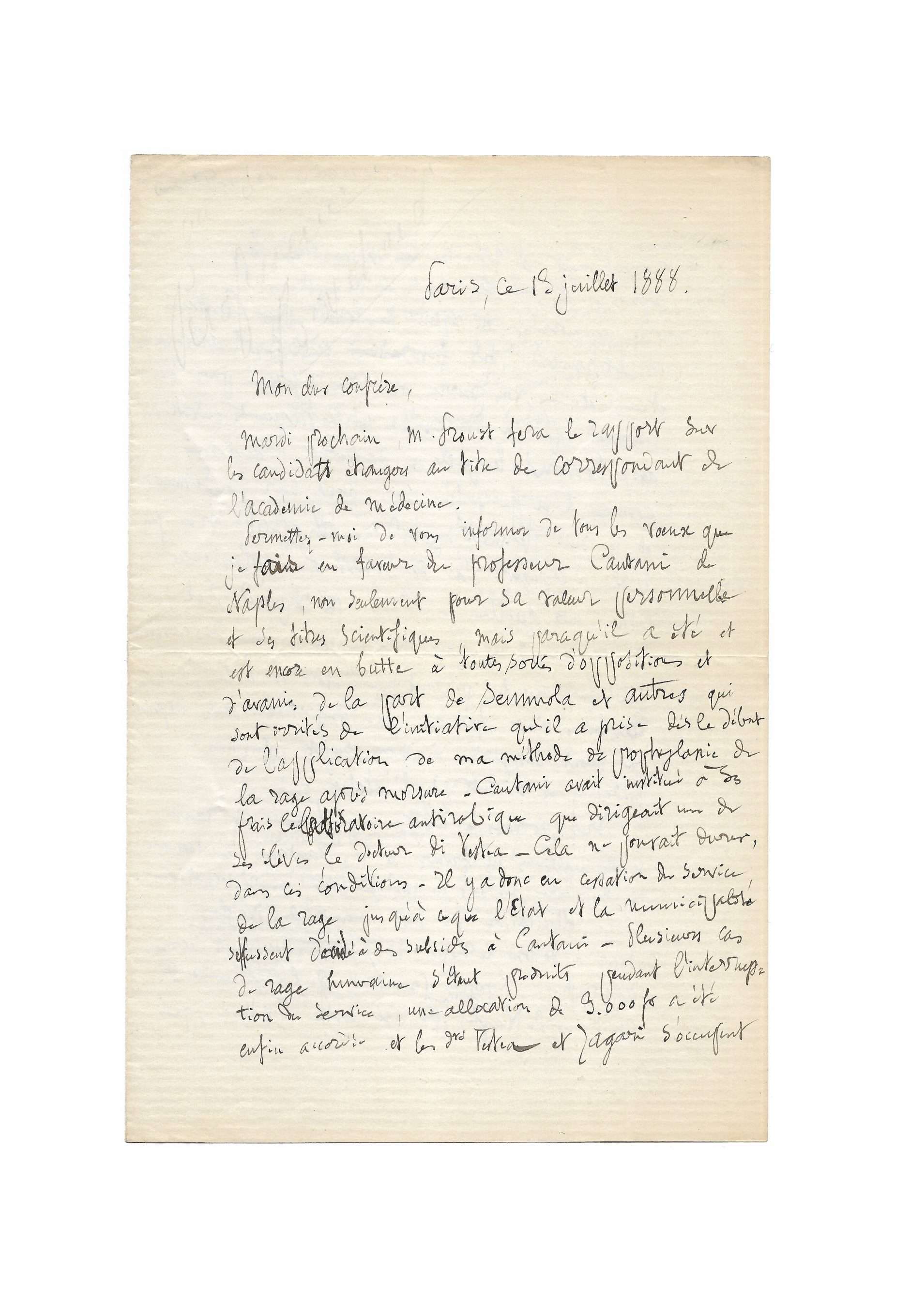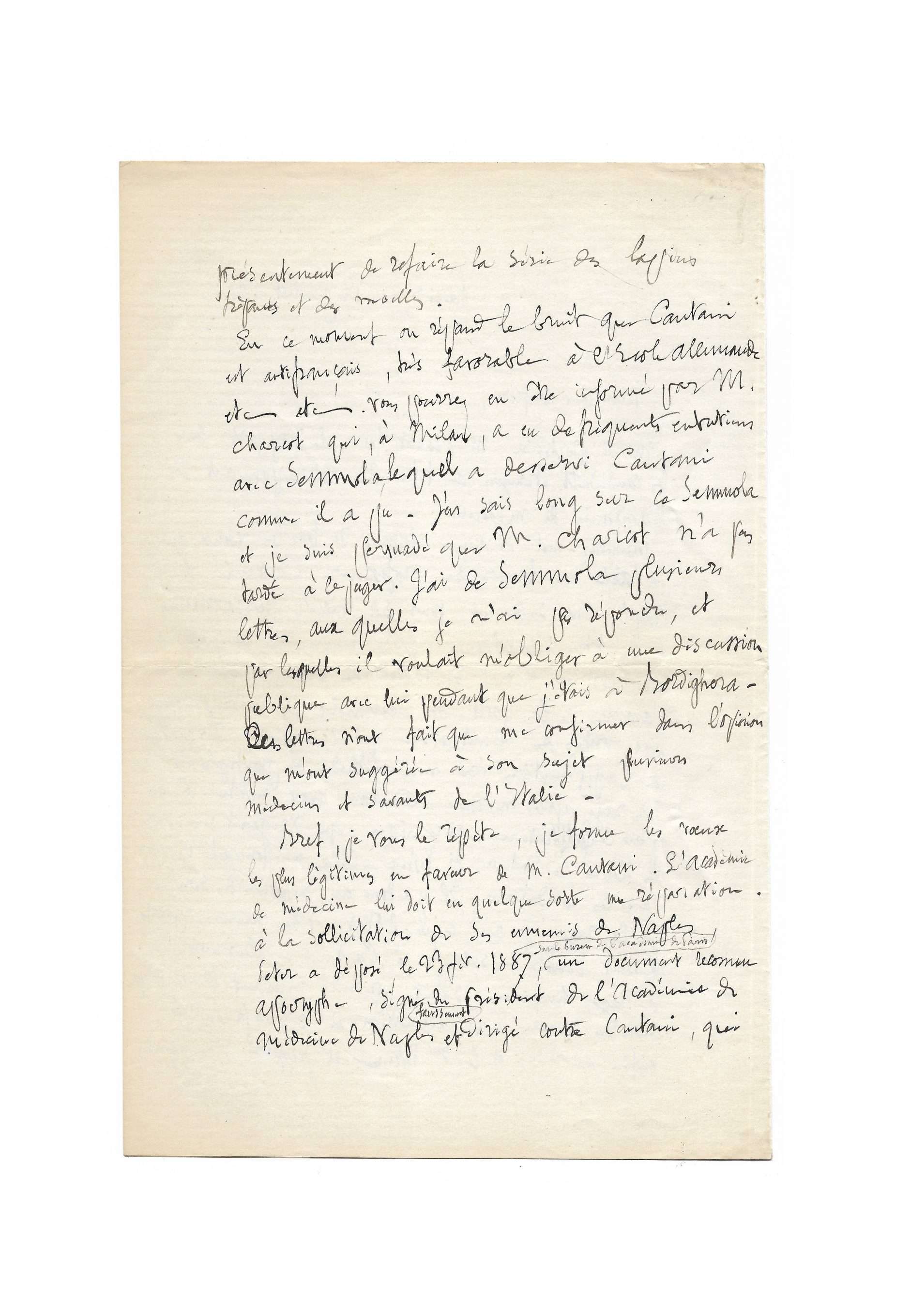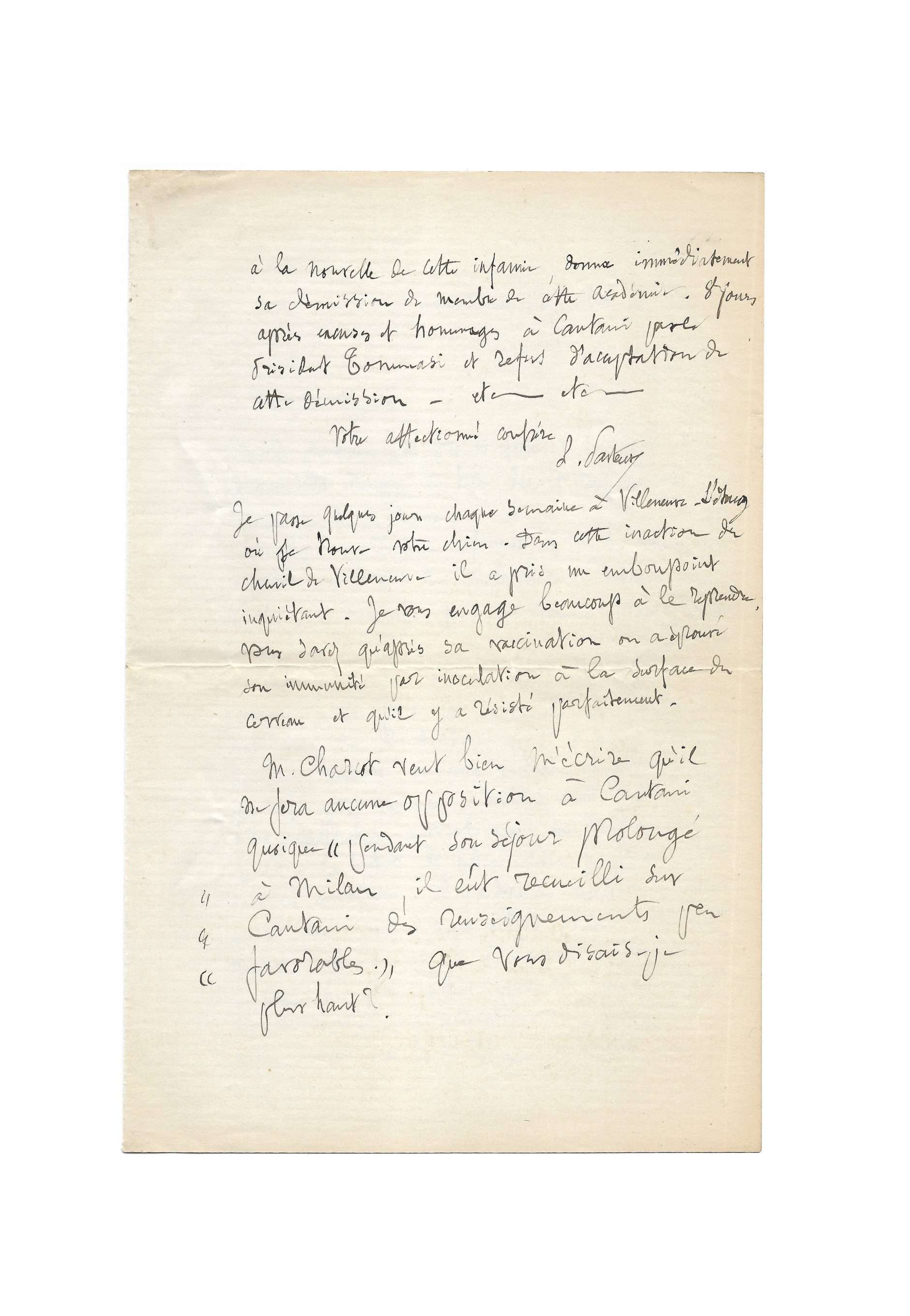PASTEUR, Louis (1822-1895)
Autograph letter signed « L. Pasteur » to Professor Charles Bouchard
Paris, 19 July 1888, 3 pages in-8°
« We have tested his immunity by inoculation on the brain’s surface »
Fact sheet
PASTEUR, Louis (1822-1895)
Autograph letter signed « L. Pasteur » to Professor Charles Bouchard
Paris, 19 July 1888, 3 pages in-8° on double folio
Usual fold marks
Important letter, testifying to the strong tensions within the Franco-Italian scientific community – Pasteur is indignant at the means used by his detractors to hinder the work of his colleagues on rabies prophylaxis
« Mon cher confrère,
Mardi prochain, Mr [Adrien] Proust fera le rapport sur les candidats étrangers au titre de correspondant de l’Académie de médecine.1
Permettez-moi de vous informer de tous les vœux que je fais en faveur du professeur [Arnaldo] Cantani de Naples2, non seulement pour sa valeur personnelle et ses titres scientifiques, mais parce qu’il a été et est encore en butte à toutes sortes d’oppositions et d’avanies de [Mariano] Semmola et autres qui sont irrités de l’initiative qu’il a prise dès le début de l’application de ma méthode de prophylaxie de la rage après morsure.3 Cantani avait institué à ses frais le laboratoire antirabique que dirigeait un de ses élèves le docteur [Alfonso] di Vestea. Cela ne pouvait durer, dans ces conditions. Il y a donc eu cessation de service de la rage jusqu’à ce que l’état et la municipalité se fussent décidé à des subsides à Cantani. Plusieurs cas de rage humaines s’étant produits pendant l’interruption du service, une allocation de 9.000 fr a été enfin accordée et les Dr Vestea et [Giuseppe] Zagari s’occupent présentement de refaire la série des lapins trépanés et des moules.4
En ce moment on répand le bruit que Cantani et anti français, très favorable à l’école allemande etc etc. Vous pourrez en être informé par M. [Jean-Martin] Charcot qui, à Milan, a eu de piquants entretiens avec Semmola lequel a desservi Cantani comme il a pu. J’en sais long sur ce Semmola et je suis persuadé que M. Charcot n’a pas tardé à le juger. J’ai de Semmola plusieurs lettres, auxquelles je n’ai pas répondu, et par lesquelles il voulait m’obliger à une discussion publique avec lui pendant que j’étais à Bordighera. Ces lettres n’ont fait que me confirmer dans l’opinion que m’ont suggéré à son sujet plusieurs médecins et savants de l’Italie.
Bref, je vous le répète, je forme les vœux les plus légitimes en faveur de M. Cantani. L’Académie de médecine lui doit en quelques sortes une réparation. À la sollicitation de ses ennemis de Naples, [Michel] Peter5 a déposé, le 23 fév[rier] 1887 sur le bureau de l’académie de Paris, un document reconnu apocryphe, signé faussement du président de l’académie de médecine de Naples et dirigé contre Cantani, qui à la nouvelle de cette infamie, donna immédiatement sa démission de membre de cette académie. 8 jours après excuses et hommages à Cantani par le président [Salvatore] Tommasi et refus d’acceptation de cette démission etc. etc.
Votre affectionné confrère
Pasteur
Je passe quelques jours chaque semaine à Villeneuve-l‘Etang où je trouve votre chien. Dans cette inaction du chenil de Villeneuve il a pris un embonpoint inquiétant. Je vous engage beaucoup à le reprendre. Vous savez qu’après sa vaccination on a éprouvé son immunité par inoculation à la surface du cerveau et qu’il y a résisté parfaitement.6
M. Charcot veut bien m’écrire qu’il ne fera aucune opposition à Cantani puisque « pendant son séjour prolongé à Milan, il eût recueilli sur Cantani des renseignements peu favorables », que vous disais-je plus haut ? »
1 – Adrien Proust (1834-1903), father of Marcel and Robert Proust, was a French physician. He was elected as a full member of the National Academy of Medicine in 1879 and served as annual secretary from 1883 to 1888. He inaugurated Pasteur’s monument in Chartres shortly before his death in 1903.
2 – Arnaldo Cantani (1837-1893) is an Italian physician and politician. His research has led to significant advances in the pathogenesis of infectious diseases. Evidenced in this letter, Cantani, a strong supporter of Pasteur’s work, established a microbiology laboratory in Naples, recognized as the first Italian institute for rabies therapy.
3 – Mariano Semmola (1831-1896) is an Italian physician, philosopher and politician. The scientific dissension between Cantani and Semmola was already very strong at the time of the cholera epidemic that was spreading in the Naples region as early as 1884.
4 – Cantani and his students were pioneers in the treatment of certain infectious diseases in Italy with germs less pathogenic than those responsible for rabies. In 1887, Pasteur had communicated that the development of pathogenic microorganisms could be inhibited by the presence in the culture of other non-pathogenic germs.
5 – Michel Peter (1824-1893) was a French physician. He was elected at the National Academy of Medicine in 1878. Known as one of Pasteur’s main detractors, he countered his theories and experiments, including the rabies vaccine, both in France and abroad. The long controversy between the two men led to the conclusion that it was not always enough for an infectious germ to enter an organism for an infectious disease to occur (healthy carrier theory).
6 – Pasteur refers here to his method (inspired by Roux’s experiments) of inoculating the rabid marrow by trepanation increasingly virulent in order to make the dog resistant to the rabies virus.
His discovery of the rabies vaccine in 1885 brought Pasteur worldwide recognition. The Academy of Sciences offered him to inaugurate an institution to treat rabies: the Pasteur Institute was born in 1888.
Charles Bouchard (1837-1915) was a renowned French physician, anatomopathologist, prolific biologist and clinician. He is known among other things for the concept of self-intoxication and medical antisepsis.
Jean-Martin Charcot (1825-1893) is a French neurologist and professor of pathological anatomy who pioneered the discovery of amyotrophic lateral sclerosis (a neurodegenerative disease to which his name was given). He joined the Academy of Medicine in 1873.
Bouchard and Charcot dedicated a great part of their work to neuropathology and more specifically to the multiple sclerosis of the spinal cord. Together they discover the origin of intracerebral hematomas, the rupture of small milliar aneurysms on the wall of cerebral arterioles that will later be referred to as the “Charcot and Bouchard micro-aneurysms”.
Unpublished letter





